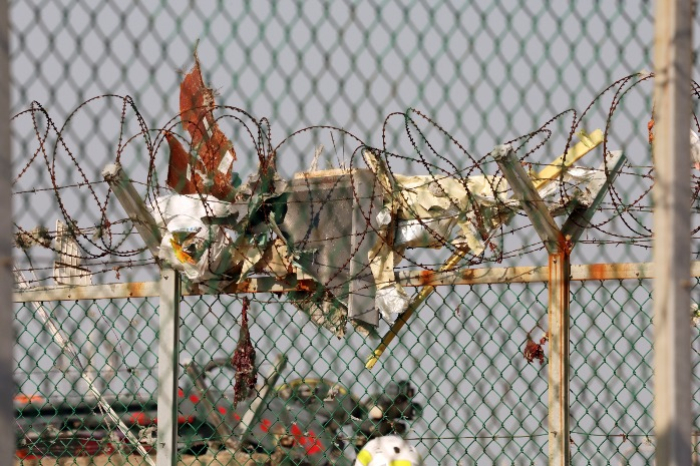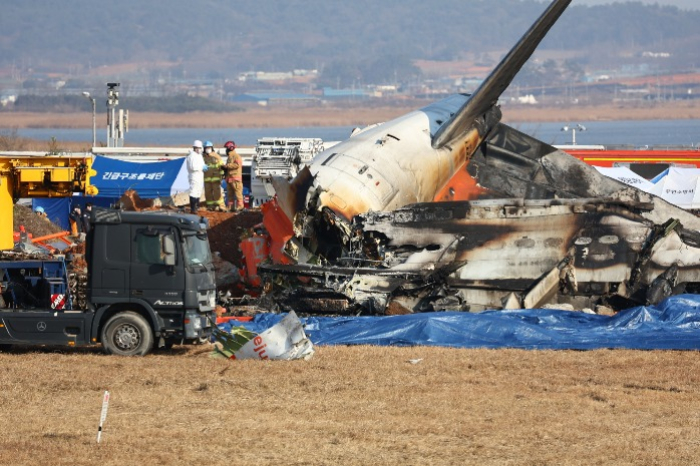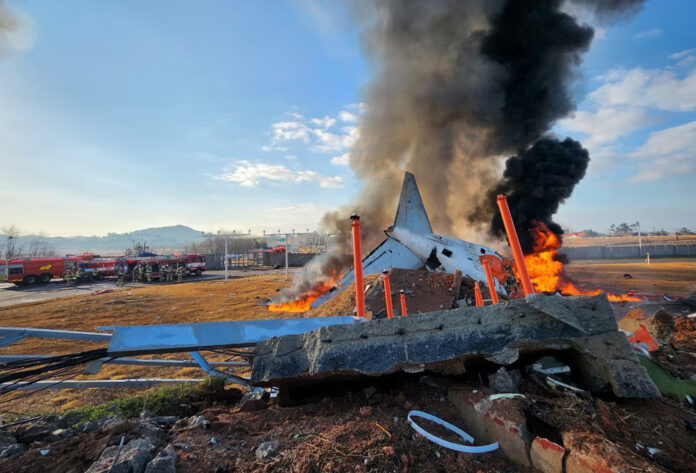A devastating air disaster unfolded at Muan International Airport in South Korea’s southwestern Muan county on Sunday morning, leaving a scene of carnage and raising serious questions about aviation safety.
A Jeju Air Boeing 737-800, flight number yet to be officially released, carrying 181 people – 175 passengers and six crew members – crashed and erupted into flames upon landing, resulting in the tragic loss of 179 lives. Only two crew members survived the horrific accident.
The flight, originating from Bangkok, Thailand, was scheduled to land at 8:30 am. However, initial attempts were thwarted by a failure to deploy the landing gear. Approximately 30 minutes later, at 9:07 am, the aircraft attempted a belly landing.
Horrific footage, widely circulated on Korean news channels, shows the plane skidding along the runway before impacting a concrete wall near the runway’s end. The ensuing explosion and fire engulfed the aircraft, leaving it almost entirely destroyed, with only the tail section remaining somewhat recognisable.
Horrifying footage emerging of a Jeju Air Boeing 737-800 (not a Max) with 175 onboard involved in a crash at Muan International Airport in South Korea — video shows the aircraft attempting a ‘belly landing’ (without its landing gear extended) before impacting the perimeter wall pic.twitter.com/C3JCUz8Iw8
— Alex Macheras (@AlexInAir) December 29, 2024
The swift and intense fire severely hampered rescue efforts. By midday, rescue workers had confirmed at least 96 fatalities, but with the extent of the damage, all but two on board were presumed dead. The South Jeolla authorities immediately escalated the emergency response to the highest level, deploying all available rescue and police personnel to the scene. The rescue operation quickly transitioned into a recovery operation, focusing on retrieving the remains of the victims. The fire department expressed deep pessimism about finding any further survivors, citing the extensive destruction of the aircraft.
Among the passengers were two Thai nationals, confirmed by Thailand’s Foreign Ministry. The identities and nationalities of other passengers are still being ascertained.
The cause of the accident remains under investigation, but preliminary findings suggest a landing gear malfunction may have been the primary factor. Unnamed sources have indicated a possible bird strike as the cause of the malfunction. Supporting this theory, video footage from before the crash shows a fire in one of the plane’s engines while the aircraft was approaching the airport for landing. One of the two surviving crew members also reported an engine explosion and smoke as the plane approached the airport.

This tragedy marks the deadliest plane crash in South Korea since 1997, surpassing the Korean Air Lines Co. crash in Guam that claimed 229 lives. It is also the worst aviation accident on Korean soil, exceeding the toll of previous major incidents such as the 2002 Air China accident near Gimhae Airport (129 fatalities) and the 1993 Asiana Airlines crash in Mokpo (68 fatalities). This is also the first fatal accident for Jeju Air, South Korea’s largest low-cost carrier, since its inception in 2005.
In a press conference on Sunday afternoon, Jeju Air Chief Executive Kim Yi-bae offered a profound apology to all those affected by the tragedy, stating, “We will do everything we can to deal with this accident,” and pledging full cooperation with the government investigation into the cause of the crash.

The two survivors, a passenger and a crew member, both women, were rescued shortly after the crash and are receiving medical treatment at a hospital in Mokpo. Their accounts will undoubtedly be crucial to the ongoing investigation.
The aircraft involved, a Boeing 737-800, is a common model used by low-cost airlines worldwide. Jeju Air had been operating this particular plane for 15 years. The aircraft’s maintenance history and operational records will be meticulously examined as part of the investigation.
⚠️ The Jeju Air plane moments after the crash at Muan airport in South Korea
pic.twitter.com/ORTeWTaDW5— Joe (@LTSmash420) December 29, 2024
The incident has prompted a comprehensive investigation by South Korean authorities. The focus is on determining the exact cause of the landing gear failure, with the possibility of a bird strike remaining a key area of inquiry. The investigation will also examine all aspects of the aircraft’s maintenance, operation, and the pilot’s actions leading up to the crash. International aviation safety agencies are expected to participate in the investigation, given the scale and severity of the accident.
A Separate Tragedy: The Downed Azerbaijani Airliner

While initially attributed to a possible bird strike by Russian aviation authorities, a shocking revelation emerged from Azerbaijan’s investigation. Four sources familiar with the preliminary findings told Reuters that the plane was likely struck by a Russian Pantsir-S air defence system. One source stated that electronic warfare systems paralysed the plane’s communications on its approach to Grozny. “No one claims that it was done on purpose. However, taking into account the established facts, Baku expects the Russian side to confess to the shooting down of the Azerbaijani aircraft,” the source said. Three other sources corroborated this preliminary conclusion. The Russian Defence Ministry has not yet responded to requests for comment.
A US official also indicated early signs suggesting a Russian anti-aircraft system may have been involved. Canada expressed deep concern and called for a transparent investigation. Kazakhstan’s Deputy Prime Minister, Qanat Bozymbaev, stated that he could neither confirm nor deny the theory. The Kremlin, prior to the Reuters report, stated it would be inappropriate to comment before the investigation’s conclusion.
Passenger footage before the crash showed oxygen masks deployed and passengers wearing life vests. Subsequent footage depicted injured passengers exiting the wreckage. Despite the devastation, 29 survivors were pulled from the wreckage, two of whom were children. Eleven survivors were reported to be in critical condition. Images of the wreckage showed what appeared to be shrapnel damage to the tail section, further supporting the theory of anti-aircraft fire. Aviation security firm Osprey Flight Solutions also noted the possibility of anti-aircraft fire based on footage and airspace circumstances in southwest Russia.
This incident occurred amidst ongoing conflict between Russia and Ukraine, with Ukrainian drones repeatedly targeting Russian regions, prompting the activation of Russian air defences. The Azerbaijani airliner’s crash underscores the significant risks posed by military activity to civilian air travel, particularly in regions with active conflict or heightened military activity. The international community awaits the full results of the investigation into both this tragedy and the South Korean crash, demanding full transparency and accountability to prevent future disasters.












